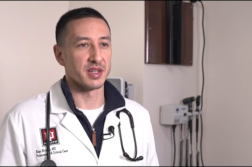CLEVELAND, Ohio. (Ivanhoe Newswire)— COVID-19 has claimed the lives of more than a half a million Americans. The largest analysis of hospitalized patients to date finds that most did not survive after being placed on a ventilator. Now, a device that helped Superman breathe decades ago is working to get COVID patients off these machines and breathing on their own.
Behind these doors … in this operating room in Cleveland … University Hospitals’ Raymond Onders was the first surgeon in the U.S. to implant a device called the Transareis system to help struggling COVID patients breathe on their own again.
“What we know, is when you’re on a ventilator, your diaphragm muscle will atrophy faster than any other muscles. Within 24 hours, you lose 50 percent of your diaphragm muscle mass,” explained Dr.Onders, chief of general surgery at University Hospitals Cleveland Medical Center.
To keep muscles from atrophying, electrodes are implanted into the muscle near the phrenic nerve, which controls the diaphragm. A small battery-powered external pulse generator stimulates the electrodes and causes the diaphragm to contract.
Dr. Onders had used the diaphragmatic pacing device on Christopher Reeve after a tragic accident left the Superman actor paralyzed from the neck down. Now, in less than 48 hours after implanting the device, some ICU patients are breathing on their own too.
“It’s kind of like aggressive physical therapy for that diaphragm. So that once your acute injury is over, we can now get you off the ventilator faster,” Dr. Onders described.
The FDA granted Dr. Onders emergency use authorization last year during the height of the pandemic. It’s also been approved for use in high-risk cardiac surgery patients, spinal cord injury patients, as well as those suffering from ALS.
Contributors to this news report include: Cyndy McGrath, Executive Producer; Marsha Lewis, Field Producer; Kirk Manson, Videographer & Editor.
To receive a free weekly e-mail on Medical Breakthroughs from Ivanhoe, sign up at: http://www.ivanhoe.com/ftk
Sources:
MEDICAL BREAKTHROUGHS
RESEARCH SUMMARY
TOPIC: TAKE A DEEP BREATH! COVID BREATHING BREAKTHROUGH
REPORT: MB #4895
BACKGROUND: Mechanical ventilation is a life-saving and necessary intervention for those who can not breathe on their own. However, when on a mechanical ventilator for an extended period of time, the diaphragm muscle, located in the upper abdomen, will have a rapid onset of ventilator-induced diaphragmatic dysfunction, or VIDD, due to atrophy of the diaphragmatic muscle. Diaphragm atrophy developing during mechanical ventilation can actually cause prolonged mechanical ventilation and even ICU admission. It can also add increased risk of complications for acute respiratory failure, according to new research published in the American Journal of Respiratory and Critical Care Medicine. The findings suggest the need for clinicians to target an inspiratory effort level similar to that of healthy subjects at rest, which could accelerate liberation from ventilation.
(Source: https://www.ncbi.nlm.nih.gov/pmc/articles/PMC4671211/)
DIAGNOSING: Prolonged mechanical ventilation contributes to increased risk of death, poor, sometimes lifelong, functional outcomes, and markedly higher healthcare costs. Diaphragm weakness is a leading cause of difficult weaning from mechanical ventilation. It remains uncertain, however, whether the changes in the diaphragm specifically due to mechanical ventilation significantly impact clinical outcomes. Recently, several animal models have provided potential mechanisms for mechanical ventilation-induced effects on muscle function. Animal studies demonstrated that diaphragm force was already decreased after 12 hours of controlled mechanical ventilation and this worsened with time spent on the ventilator. Diaphragmatic myofibril damage observed after 3-days controlled mechanical ventilation was inversely correlated with maximal diaphragmatic force. These animal studies show that early alterations in diaphragm function develop after short-term mechanical ventilation.
NEW TECHNOLOGY: Raymond Onders, MD, Chief of General Surgery, University Hospitals Cleveland Medical Center told Ivanhoe, “Diaphragm pacing is a system we’ve been working on here at University Hospital’s Cleveland Medical Center for over 20 years. What we know is, when you’re on a ventilator, your diaphragm muscle will atrophy faster than any other muscles. Within 24 hours, you lose 50% of your diaphragm muscle mass. So many times, we put patients on a ventilator to help them oxygenate and we also help them ventilate and moving carbon dioxide out. So when somebody has an acute problem, such as a trauma, such as an open heart operation or some other problem where they’re going to be on a ventilator for a certain period of time, we’re maintaining that ventilator until they get better and then we have to do physical therapy for the diaphragm. We’ve shown in spinal cord injured patients such as Christopher Reeve that we can help get anybody off the ventilator by working on their diaphragm with these electrodes that we placed laparoscopically in the diaphragm to maintain the muscle mass. It’s kind of like aggressive physical therapy for that diaphragm so that, once your acute injury is over, we can now get you off the ventilator faster.
(Source: Raymond Onders, MD, Chief of General Surgery, University Hospitals Cleveland Medical Center)
FOR MORE INFORMATION ON THIS REPORT, PLEASE CONTACT:
JEANNINE A. DENHOLM
JEANNINE.DENHOLM@UHHOSPITALS.ORG
(216) 844-2555
If this story or any other Ivanhoe story has impacted your life or prompted you or someone you know to seek or change treatments, please let us know by contacting Marjorie Bekaert Thomas at mthomas@ivanhoe.com




